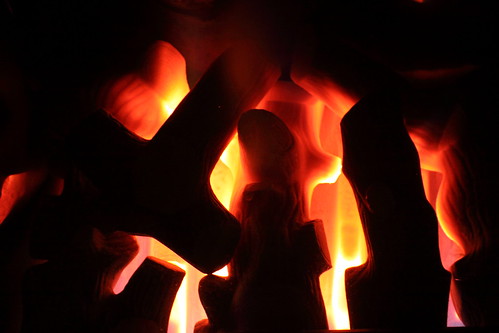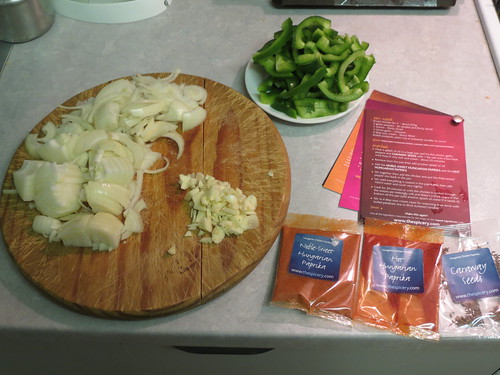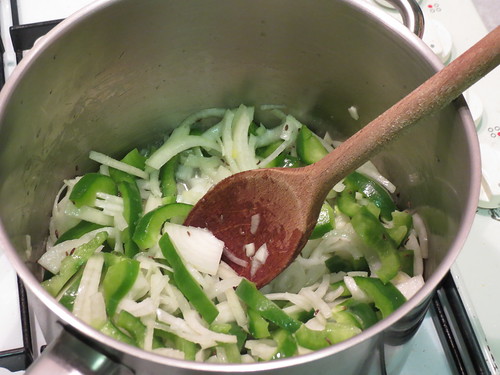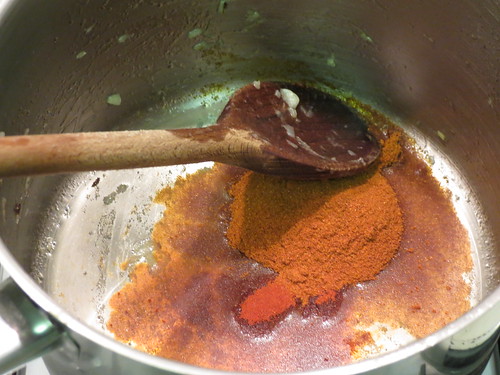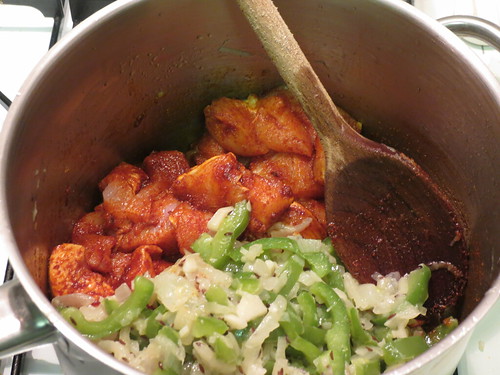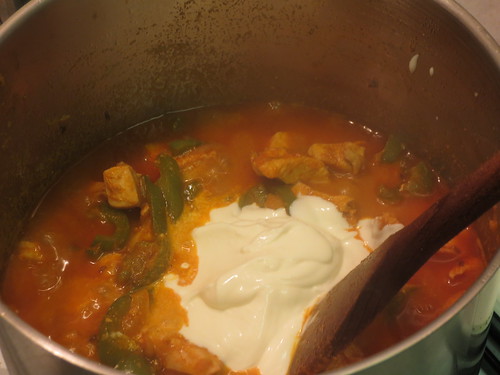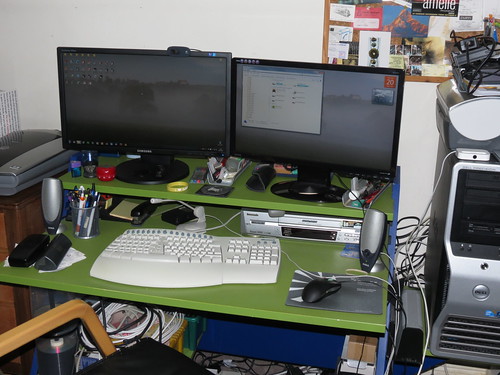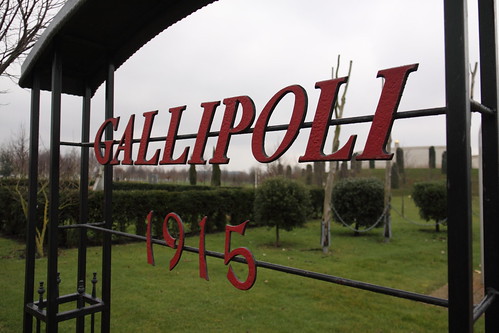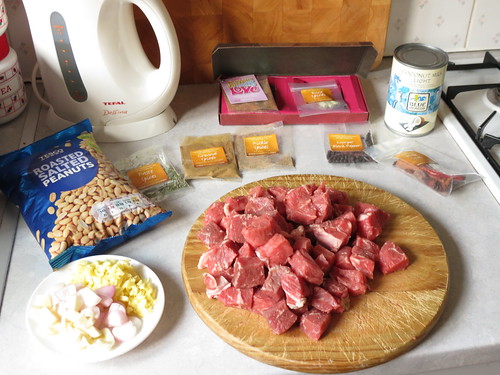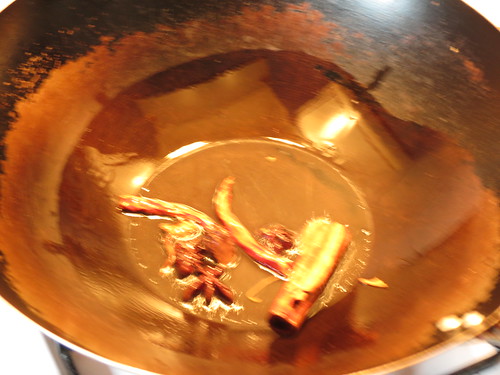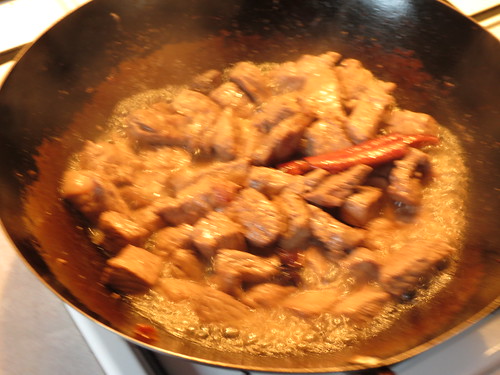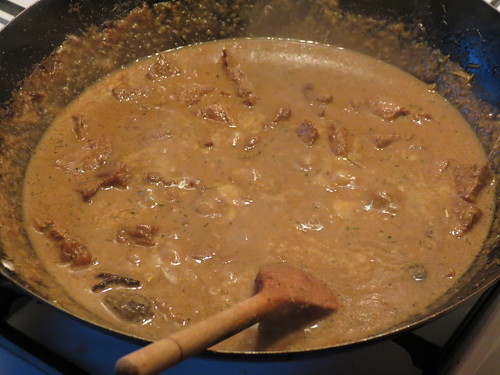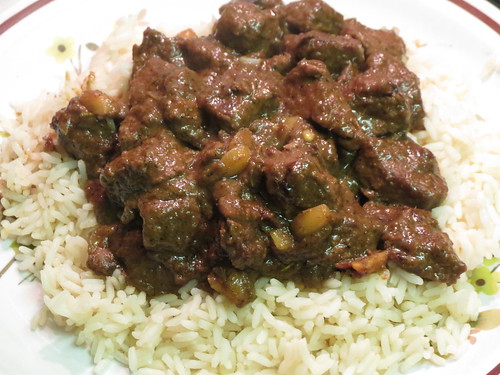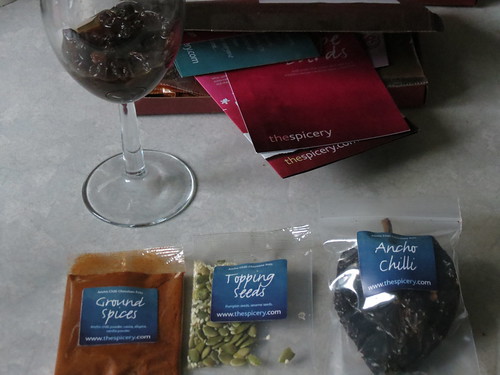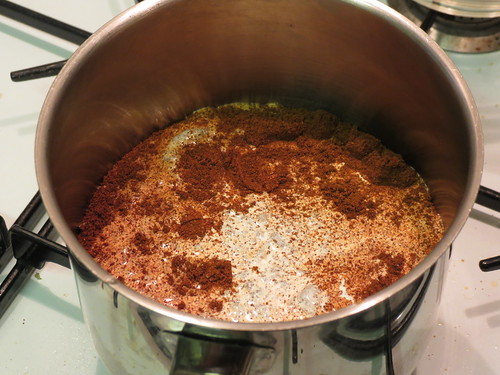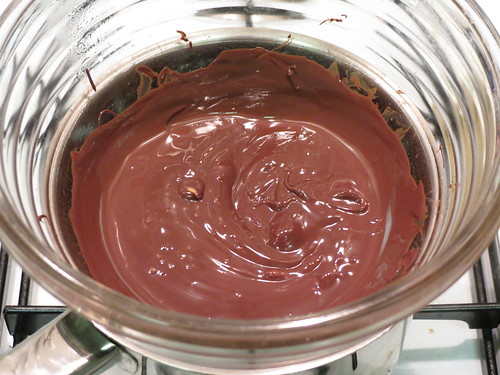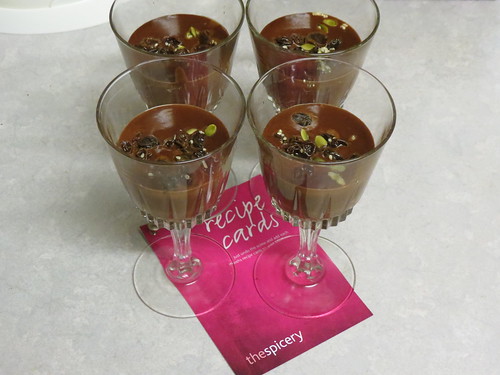The clocks went forward last night, and I've been wandering around the house resetting the time on a bewildering array of electronic equipment, very little of which actually needs a clock in order to function. My watch, my mobile phone, my PC and my radio are the only items that managed to update themselves without manual intervention. None of the things I have that should update the time based on the radio signal from the NPL has managed to do so. I've still got my studio gear to update, too - I'll get round to doing that this afternoon.
It's still cold outside, but there's a nice patch of blue sky visible through the window today. My cold finally seems to be on the way out, too; I shall finish it off tonight with a chicken madras curry made with spices from The Spicery so tomorrow you can expect another batch of cookery photographs, I'm afraid.
In all the years that I've made music using computers, I've always gone down the PC route. But I also have a mac, and with my current DAW on its last legs at the moment I finally decided to fire up my ancient copy of Garageband and see if I could do anything with it. My mac's headphone output is hooked up to my studio monitors, but everything else is plugged into the PC. I wondered - was it practical to start swapping things over?
I came up with an answer very quickly: no, it wasn't. I failed at the first hurdle. The mac doesn't come with any means of getting an audio signal into it. There is no audio input socket at all. Despite how ludicrous this is, I've been using Apple's products for long enough now that it didn't come as a surprise. The Apple approach would, no doubt, be to offer a version of the hardware with this "additional functionality" for a grossly extortionate sum, despite the fact that even the cheapest PC provides an audio-in jack as standard. But I've had enough of buying things from Apple only to find that they become out of date alarmingly quickly. I'm not going to be rushing out to buy yet more hardware for something that I was using as a Saturday afternoon workaround. As I would be keeping the set-up as it was (i.e. without spending any money), what could I do with it? Was it worth plugging the Korg into the USB socket at the back and - assuming that I could find drivers that worked - playing stuff in via MIDI? What was Garageband actually like to use?
First of all, I should make an important point. The Dell PC I've been using is nine years old and it will happily run the full version of Ableton that came out three weeks ago (although it struggles with the processor-intensive stuff.) But Apple operate under a different scheme of things. The mac is three years newer than the Dell, but I can't upgrade the OS on it because the processor is no longer supported. That means I can't upgrade the version of Garageband that came with it. The lack of backwards compatibility is a big reason why I won't be buying anything else from Cupertino's finest, but it's only fair to point out that my impressions are of a version of the program that is five or six years old. Apple may have improved things since the version I was looking at came out, but on the other hand, this is Apple we're talking about - so I very much doubt it.
I tried to work up some enthusiasm for using the program, I really did, but the design touches really grated. Some of Apple's cheesier designers really love their skeuomorphs - did the program really need faux wood panels at either side of the main window? But the program's functionality also annoyed me. Did the input piano keyboard really need to disappear every time I clicked on the main window? Did the help facility really mean for me to have to navigate back to the contents page to navigate to the next topic rather than giving me "forward" and "back" buttons? And, while we're at it, did the help system have to limit each basic page to a couple of sentences and make me have to click on a "click for more info" link to read the information that should have been on the initial page in the first place?
There's a collection of samples and loops provided with the program, and a clunky browser that you can set to display different categories of music (like "orchestral" or "single") to narrow your search. Mystifyingly, some of these category buttons were disabled - why display them if there's no content for them to display? Oh, wait - I get it. This is Apple. No doubt you have to spend more money to get the content associated with those buttons to work...
Some of the samples that came with the program were pretty decent. There were some nice live drum loops, for example. You can drop samples into a track-based timeline and loop them in much the same way as you can in Ableton. But if you want to transpose a loop for a key change, you can't click on it to edit it like you do in Live, oh no - you have to open the master track (which is, naturally, completely hidden by default) and select the section of the recording you want to transpose there instead. By the time I'd discovered all this, I'd had enough.
There are two very different approaches to design at Apple - on the one hand they will make stuff that just works, that looks elegant, that outclasses everything else on the market (for about six months, until a newer version comes out.) But on the other hand they produce, clunky, naive, childish versions of things that are frustrating for grown-ups to use because in order to perform basic, every day tasks you're forced to go round the houses and do things in counterintuitive ways. Microsoft have clearly been taking lessons here, because the latest version of Office takes exactly the same approach. My Saturday afternoon didn't result in any new music, then, but it did make me realise just how good the Ableton and PC solution I currently use really is.
Doctor Who returned last night. After a bit of early shenanigans involving monks (which explained the title of the episode: "The Bells of Saint John" turned out to be the ringing of the St. John's Ambulance telephone set into the door of the Tardis), the Doctor rapidly found Clara again, this time in contemporary London.
There were some nice little touches. I spotted James Corden as one of the captured people on the video wall (he was on the right). I loved the bad guy's comment about mistaking the "real" Tardis in Earl's Court for the Doctor's blue box - "That was embarrassing." I loved Matt Smith roaring out of the Tardis on the South Bank on a Triumph Bonneville. I loved how the futuristic architecture of the Shard fitted in with the show. Moffat's dig at Twitter was hilarious. And we got Richard E Grant as the Great Intelligence, a character referenced in last year's Christmas special that goes way back to the days of Patrick Troughton and the Yeti.
But it felt a bit by-the-numbers. The Doctor stayed several steps ahead of things at all times, and there was little or no menace from the villains. The dialogue designed to portray them as ruthless killers, where Celia Imrie discusses executing one of her staff, made absolutely no sense after we discovered that she could effectively control each minion's memory and motivation with an app on her iPad. Another thing that made no sense was the Doctor's refusal to take the Tardis into battle. Since when has he decided the Tardis is too powerful to risk falling into the wrong hands? I seem to remember him flying it into the main control room of the Dalek battle fleet last time out. The line simply gave an excuse for a very cheap gag involving driving the Triumph up the side of the Shard.
I still have no idea where the Clara storyline is going - the fact that the Doctor keeps meeting the same girl time and again makes no sense and the fact that this happens even after she's died several times even less. And that has me intrigued. I just hope we get a satisfying explanation for it all rather than some handwavy legerdemain that leaves me disappointed.
It's Good Friday, and I'm at home for a long weekend. I normally sleep in late during the holidays and always regret doing so - by lunchtime I'm only just getting started and that's half the day wasted. On work days I'm an early riser and I'm usually pulling in to the office car park as the 7 o'clock news finishes on Radio 3. Today I intended to have a lie-in of some sorts, but even though I'd remembered to turn the alarm clock off last night I still woke up at 7 this morning. Rather than turning over and going back to sleep, I decided to get up instead. This was primarily because I've got a head full of a cold and I was desperately in need of coffee, but also because the heating had gone off and the house felt distinctly chilly (it was -3°C outside when I checked). After the house had warmed up and I'd had breakfast I felt much better and ready for a day of being creative.
I'm hoping to get a few more pieces of music recorded before I go back to work on Tuesday, and I had a productive session of synthesiser programming this morning. But for the last hour I've been locked in a battle with the recalcitrant Dell PC that I use as my DAW. As I mentioned a few days ago, it's been misbehaving. Well, I say misbehaving. Misbehaving now involves not only crashing every fifteen minutes but also NOT MAKING ANY SOUND which is somewhat problematic for a machine I'm supposed to be using to make music. Today I downloaded the latest drivers for its sound card in the hope that they might sort things out, but to no avail. It's just BSOD'd on me again, so I've given up. Its replacement arrives in just under a fortnight and I'll use my laptop until then. Mind you, the lash-up and hacking I did a year ago has got me another 12 months use out of the thing so I can't really complain. I'll strip everything resuable out of it and then it'll be off to the recycling centre with the bits left over. That'll teach it to misbehave.
It's actually above freezing outside at the moment, but the weather has been bitterly cold this month. I was so cold on Tuesday night that even with the central heating on I was shivering. Eventually I pulled the gas fire in the living room apart to see if I could coax it back into life and get some extra heat into the house. I don't think I've used the fire in ten years, and the last few times when I've tried lighting it, nothing happened. I thought the ignition circuit had given up the ghost so I was gobsmacked when, after I found a fresh battery and clipped it into the starter, I finally got a result and the thing burst into flame...
It was very nice to sit in a toasty warm living room and not be shivering from the cold. I've just put the fire back on, partly because it's still not very warm in here, but also to convince myself that the fire does still work and I wasn't just imagining it.
My gas fire skills are obviously on top form this week, too - I ended up in the plant room at work yesterday morning helping to relight the boilers for the heating after they'd all tripped offline. Well, it made a change from writing avionics test procedures...
I think I'm coming down with yet another cold. Last night after doing the washing up I put the headphones on to listen to some music, and the next thing I remember is waking up at ten o'clock and realising it was time to go to bed so I didn't get round to writing up the weekend's culinary exploits until this evening. But here we are, so let's get started...
I was cooking again with a kit from The Spicery thanks to the subscription Ruth gave me. This time round the recipe involved lots of paprika and some caraway seeds, as I was making a Hungarian dish called chicken paprikás. The ingredients list this time round wasn't quite so intimidating as the saraman curry, so I remembered to set the camera correctly before I took any photographs. The box still smelled wonderful, though.
I started off by finely chopping some onions, garlic, and green peppers which I chucked in a large pan with "a splash" of oil, a teaspoon of salt, and fried them with the caraway seeds over a low heat for 20 minutes or so. I wasn't expecting them to caramelise, and they didn't - everything just softened up nicely.
I parked the resulting mixture in a bowl while I fried up two different types of paprika in the same pan with some more oil. The recipe calls for a small quantity of spicy, hot Hungarian paprika and a larger amount of "noble sweet" Hungarian paprika. Before the weekend I had no idea that different types of paprika existed. As a typical Brit I just assumed paprika was the generic orange powder you see for sale on the supermarket shelves, but these packs were noticeably different colours (the hot paprika was darker) and when I opened them they smelled differently, too.
The Spicery say that one variety of paprika is "brutally hot" so of course now I want to track some down and give it a try, but the spices I was using weren't that aggressive. Never mind - as I fried them in the oil they generated a lovely aroma. Once the paprika oil mixture was ready, in went the diced chicken breast, and when that was evenly coated it was followed by the fried onions, peppers and garlic that I'd put to one side.
I gave things a quick stir so that everything was coated in the spices, then added some water and plonked the lid on the pan. And that was it for a further twenty minutes - it's not a demanding dish to make at all. When the timer went off it was time to have a look at the results; I could really smell the caraway seeds when I took the lid off the pan. I'd ended up with a rich, exotic-looking stew that was calling out for a few dollops of sour cream to be added, so in it went...
And that was pretty much it. After adding the sour cream the aroma of the paprika really came through and the kitchen smelt great! I left the stew to stand for a minute or so while I finished preparing the boiled potatoes.I served the paprikás with new potatoes, although it's traditionally eaten with buttered noodles. You can also serve paprikás with rice, but I'd had rice with a curry the previous night and anyway, new potatoes go with just about anything, right?
So, how was it? As expected, it was quite something. It was quite a mellow dish thanks to the sour cream, but rich and satisfying. I think it says a lot about just how good it was that I ended up mopping up the leftover sauce with a slice of dry bread because I really didn't want to leave anything on my plate.
It's a very easy dish to make, too. The chicken was tender and I could taste the paprika as a mellow catch in the throat rather than a distinct burn. The recipe says to use a pan with a tight lid (I guess so that the dish won't lose too much liquid during cooking) but mine might have been a bit too tight; I thought the sauce turned out ever so slightly on the thin side although I'm sure freezing will improve it. I think I might use a bit less water next time so that the sauce ends up thicker, and I'll be a bit more sparing on the oil. But it's a dish I'd definitely make again, even though I have a couple of servings in the freezer left over from this session to get through first. Somehow I don't think they'll stay in the freezer for long.
Despite the temperature remaining around freezing I've seen and heard a few signs of spring this week. Some of the spring migrants are beginning to arrive and the birdsong I hear in the mornings has begun to vary more than the winter fare of robins, blue tits a nd blackbirds, although I've yet to hear the main harbinger of spring, the chiffchaff. On the way home last night I was surprised to see a weasel dash across the road in front of the car. In West Yorkshire, though, things look like the county is inside the arctic circle...
The clocks may go forwards next weekend but here in the UK anywhere north of Hereford seems to be in the grip of snowmageddon. Here there's no snow but it's a chilly, grey Saturday afternoon and I've just put the heating back on. The thermometer says it's nearly 3°C outside but it feels much colder than that even after fortifying myself with a cup of tea and a couple of hot cross buns. This time last year it was lovely and warm; the sun was shining, and I was blogging about getting the lawnmower out to cut the lawn. On the other hand, last year the UK went on to experience one of the most dismal summers I can remember, so who knows how things will turn out...
I'm beginning to suspect that my old Dell PC reads my blog. How else do you explain the fact that the next time I went to use it after writing earlier in the week about retiring it, it BSOD'd on me not once, not twice, but six times in the space of 90 minutes? After much grumbling and swearing I've ordered my new machine, which should be delivered just after Easter. I ordered a new monitor too, as the existing Benq monitor only has one DVI and one D-SUB connector (and the Mac Mini has first dibs on the DVI socket) and - well, display technology has moved on somewhat since then. The new monitor still has a D-SUB socket but it also has DVI and HDMI connectors and it's already arrived, so I've moved the old Benq downstairs to act as a second monitor on my "main" machine (the one I'm using right now). As one monitor cost nearly twice as much as the other I can't really complain about not being able to get the colour temperatures to match exactly, but I've got them so that they're pretty close. With two widescreen displays in front of me it feels like I'm sitting at Mission Control, but I've had a two-monitor setup at work for nearly a decade now and it's actually very useful when I'm working on more than one document at once.
I've ended up ordering my new machine from Mesh Computers, as they offered a great base spec that I could configure just how I wanted. Importantly, they offered Windows 7 as an alternative to Windows 8 as an option for the operating system. I'm looking forwards to seeing what the new machine can do - especially as having the OS on an SSD and running 4 terabytes of HD storage with 16 gigabytes of RAM should make quite a difference in performance over the old machine, which runs on a Pentium 4. In the meantime I've been using the laptop for noodling with Ableton, and it's stood up to things very well. It now has the whole of Suite 9 installed: all 54 gigabytes of programs, loops and samples. There are multiple drum kits, horn sections, string sections and vintage synthesiser sounds to play with and I've started getting to grips with the audio capabilities which Live and Max for Live offer me. I spent a couple of hours this morning playing with Impulse, creating loops and working my way through some of the chapters in the Live manual and in the process I came up with something promising - at least, it was striking enough to make me stop and say "whoa!" I saved the file immediately so I didn't lose it. I'd made it from a recording of a Sea King helicopter flying over my house last year, but ended up with a very rhythmic pattern that sounded nothing like an aircraft. I experimented with layering a percussion loop over the top of it and adding samples from Live 8, and I think the results have got potential. I'll work with over the next few days to see what I can make with it and I'll upload something to Soundcloud when I'm happy with it.
This evening I will mostly be cooking with a kit from The Spicery again. Rest assured I'll be blogging about the results.
It's been out in the wild for a couple of weeks now, and although I haven't spent a huge amount of time on it yet, I'm enjoying playing with Ableton's Live 9 suite immensely. It's given my sonic palette a huge boost, as according to the website the full release includes something on the order of 54 Gigabytes of sounds. These are all available to download from Ableton's website for registered users, but as that's nearly double my monthly download allowance I've gone distinctly old-school and a physical copy of the discs is currently winging its way to me from Germany. The physical box also comes with a printed version of the manual, and believe me, I'll need to be reading that a lot over the coming months. Ideal bedtime reading...
I spent Saturday using the Launchpad to trigger a selection of the samples that I have downloaded so far. There are some absolutely mental drum samples which I'm planning to have great fun with. But before that happens, I'll have to sort out my gear. My initial optimism that the nine-year-old Dell I've been using for my studio set-up would cope with the increased demands for brute processing power that the new version makes have, sadly, vanished. It seemed so fast when I got it, back at the beginning of December 2004! I actually managed to crash the computer on Saturday evening with Live's CPU usage meter stuck at 266% and the sound card fell over so spectacularly that only a hard reboot of the system could stop it screaming in agony. To be fair, even my laptop (which has an Intel Core i5 processor) struggles, running the same construction kit (The Forge by Hecq) with the meter at 110%. But the laptop will run the first of Hecq's demo songs (which made the old machine give up completely) with the meter hovering around a very modest 34% and when it plays the second the meter doesn't even creep above 11%. I suspect that the old Dell is on its way out, anyway - it suffers from a very noisy fan for the first half hour or so when it's powered up and despite the fact that I upgraded its power supply last year, it seems to struggle with keeping the wireless networking card powered. So I'm going to retire it and get something a bit beefier that doesn't rattle or whine; I've already got my eye on a Core i7 system that should do the job. Why Core i7? The thing is, Ableton recommend that you stick with the 32-bit version of Live 9 rather than the 64-bit version, and the 32-bit version can only access a maximum of 4 Gb of RAM (the 64-bit version can theoretically access sixteen Exabytes - that's sixteen million terabytes - of RAM, which made me whimper when I found out). So I'm probably better off spending my money on a system with more processor cores (the i7 has six) than I am buying one with stupid amounts of random access memory. Of course, I could always get myself a system which has both. For the purposes of future-proofing, you understand...
Meanwhile, I'm still feeling intimidated by Max for Live. It's a programming interface that lets you tweak the sounds, instruments and control parameters that are used by Live as well as build new ones of your own, and that's every bit as complicated as it sounds. The Suite 9 install comes with an enormous selection of Max for Live bits and pieces such as Convolution Reverb, which (as far as I can make out) works by modelling the behaviour of reverberation based on a sample of a real space responding to an instantaneous sound like a spark gap. The waveform you end up with is called an Impulse Response (IR) and with Max for Live you can even load your own IRs into the device. The software will then make any input signal die away in the same way as the IR in the original recording. Clever, eh? The University of York's OpenAir project has made a large number of these IR files available for free online and several of them, such as York Minster, the Tyndall Bruce Monument, the typing room at the Terry's of York chocolate factory and St. Albans Cathedral have made their way into the Ableton release. The delay time for the York reverb is over 7 seconds and sounds great, but one of the other presets is a simulated space that has a sixty-second delay. It sounds lush beyond imagining!
The last couple of nights I've been woken up at around 4 in the morning to hear a diesel van roaring off into the distance - so I suspect my current bout of insomnia is being caused by the local milkman. Whatever happened to the days of lovely, silent, electric milk floats? And what happened to consideration for people trying to sleep, for that matter?
Still, I did get a piece of music out of it. I've explained why I've called it 4:04 am - time not found over on the tune's Soundcloud page...
To be honest I'd much rather have had an uninterrupted night's sleep, but I like the way a recording of rain that I made last summer works with the music. I might try a few more tracks blending field recordings and played instruments and see what happens.
I spent yesterday afternoon at the Charfield Village Plan event at the Village Hall. The place was packed - there were far more people there than I'd expected and it was rather nice to realise how many of them I knew. I've been living in the village for nearly 18 years now and there's a real sense of community to the place. Needless to say some of us ended up having a pint in the Railway Tavern afterwards. Well, you've got to support local businesses, haven't you?
The plan encompasses many different aspects of life here, from transportation (Charfield station has been at the "planned to reopen in a few years" stage since I moved here) to broadband (things are looking positive, although we've no definite news on exactly how positive) and from improvements to the village hall to the provision of allotments. And yes, that's the photo I took for the Jubilee on the front page.
Mitch Benn successfully completed his 24 Hour Album Challenge for Red Nose Day and produced 11 songs (over 31 minutes of music) in under 24 hours. He's raised over £2700 at the time of writing but there's still time for you to make a donation. You can also buy the end result of the challenge here as a download for the paltry sum of £8. It's good - I can particularly recommend "Homebrew Oblivion" which sounds remarkably like Spinal Tap to me and "If I lived on a comet" which is worth the money just to find out which words Mitch chooses to rhyme with "comet."
I had a very nice weekend in Solihull catching up with Rebecca, Rob, Ruth and Will. The trip up the motorway on Friday night was a bit of a slog as the weather was horrible and there were lots of queues through the roadworks, but I got there eventually. I didn't know Rob was coming home for the weekend and the others managed to keep me from twigging until he walked through the door, which was a lovely surprise. Ruth had cooked an extremely nice chicken casserole and afterwards we all worked our way through a bottle of port together with a very nice piece of Somerset brie with some crackers. We all sat at the kitchen table chatting until midnight.
I had the best night's sleep I've had for ages, and after breakfast on Saturday we headed over to Alrewas to visit the National Memorial Arboretum again. It's changed quite a bit since I was last there, with a bigger car park, a reorganised visitor centre, and some new memorials, including one to the battle of Gallipoli that took place in 1915...
Needless to say we also paid a visit to the Balti Society on Saturday night. That made me realise how much of an effect my diet has had, as I couldn't finish my curry; there was just too much of it. I got home on Sunday night feeling like I'd been on holiday for a week - I've had a lovely time.
Last week I made my first meals with the present I got from Ruth, a subsciption to packets of spices from The Spicery in Bath. I've been meaning to blog about the results all week but there just don't seem to be enough hours in the day at the moment. You may have seen the photos on Flickr, but the food was so good that it deserves a proper blog entry, so here it is.
The first thing I cooked was a Cambodian Saraman Beef Curry. I'm not very familiar with Cambodian food, so I didn't really know what to expect, but the spices smelt wonderfully pungent and the recipe called for salted peanuts and coconut milk as well as a decent amount of diced beef, some fresh ginger, several cloves of garlic, and some chopped shallots. I've never made anything with shallots before, so that was a first! Here are the ingredients laid out beforehand:
I had a momentary hitch when the recipe called for some ingredients to be pureed in a blender - I don't have one. But I do have one of those stick blenders and after transferring the ingredients to the emptied tin of coconut milk I was able to make a decent curry paste. By this time I was really getting into things and was so focussed on the cookery that I forgot to check the camera settings for the first half of the session, as you'll see. After frying up the whole spices in oil for a minute...
...I browned the beef in the same wok.
Then it was time to add the paste. The recipe says to fry the mixture until the paste thickens and begins to stick, which took quite a while, but I was quite happy to just stand there breathing in the smell. Eventually it started to brown at the edges, so I added the mix of spices supplied and the coconut milk. The mix was really complex; I hadn't even heard of some of the ingredients. I added a handful of salted peanuts then left the results to simmer for about 45 minutes. It steamed away quite fiercely - there was a lot of liquid to evaporate - but once things had calmed down the curry had become a rich, thick concoction that smelt absolutely amazing.
After that, all that was left to do was cook the rice and serve out the results.
It was delicious. In fact it tasted even better than I'd expected from the aroma. The saltiness of the taste left me feeling quite thirsty, and if I make this again I'll probably use half the amount of salt. I'd also probably remove the whole spices from the pan after frying them rather than leaving them in, as I failed to fish all the bits out before serving the end results so I ended up spitting out the occasional bit of star anise. But it was worth it - I was very impressed with the dish and it was a vary different taste to the usual things I cook.
I left a couple of days before attempting the dessert recipe, but on the Monday night it was time to get things moving with a big jug of double cream, some dark chocolate, and an intriguing set of spice packets, including a large and vaguely sinister-looking dried chilli pepper to make some Ancho chilli chocolate pots...
This time I was a little more prepared, and I'd soaked some raisins in brandy for a few hours beforehand. Preparation was much simpler, though: soak the chilli in boiling water, drain it then purée it with a dash of water, and add it to a pan full of cream and stir in the sachet of ground spices, like so:
After a few minutes of gentle simmering, the aroma of the chilli really started to appear. Again, the kitchen smelt amazing! With the cream mixture sorted, it was time to melt the chocolate, which rested in a bowl over the saucepan. This took about five minutes or so...
The chocolate was stirred into the original mixture, then half the raisins went in together with some pumpkin and sesame seeds:
When the mixture was nice and smooth, I poured it out into wine glasses and sprinkled the rest of the raisins and the topping seeds on top:
After a couple of hours in the fridge I gave one a try. The flavour was quite mellow - the ancho appears to be a sweet chilli rather than a fiery one, but you could still tell there was capsicum in there. The raisins in brandy, together with the huge amount of double cream means this is a hugely indulgent dish and it was very, very rich indeed. The recipe card suggests serving it with biscuits and I agree - eating one on its own was almost overwhelmingly rich. But again, I reckon I'm going to count this as a success; I've never cooked anything like this before.
I've already got the next packets from The Spicery so I'm planning my next set of culinary adventures. As ever, you'll hear about what happens here.
It's a chilly Sunday morning and I'm in the middle of an extended weekend. I'm taking Monday off - for no particular reason other than I felt like having a break - and right now I'm sitting here drinking coffee and listening to Radio 3. As I did last year now that FAWM is over I've been thinking about what I've learned about home recording techniques this time around, so I guess that means it's time for my yearly review...
1. Be prepared to abandon your plans.
Several times this year I had an idea for a song and a fairly concrete image of what it was going to sound like in my head before I started. However, once recording got under way, that idea changed out of all recognition and in the case of the original version of More Torque Than Before, the idea changed so much that I ended up making another song entirely out of some of the ideas that cropped up. In the past I'd probably have fought harder to bring my original idea to fruition and ended up frustrated when it didn't happen the way I wanted it to. This year, I decided that I'd let my subconscious do more of the work. By rolling with things as they happened, I think I ended up with a better piece of music and and in the case of The Opposite of Blocked I got another song out of things into the bargain.
2. You don't actually need plans.
As a corollary to point number 1, at several points this year I fired up all my recording equipment with literally no idea whatsoever about what it was I was about to produce in the next couple of hours. I had no melody, no lyrics, nothing. Not even a title. Yet with no foundations at all to build on, just a desire to add another song to the tally after a few hours' work, I ended up producing three of my favourite tracks from this year's sessions: Drifting Cirrus, Ancient Temples, and Broken Inkjet. I suspect that it's no coincidence that all three tracks feature me playing Chapman Stick, but I just started playing around with drum tracks and basslines until something sparked my interest. Broken Inkjet happened because I found a drum kit on the Korg that made a noise like a printer (it may well actually be a sampled printer, for all I know). I came up with a funky bassline for it on the Stick, then a truly horrendous pun for the last line of a blues song, and that was it. I think the lyrics took all of two minutes to write.
3. EQ is even more important than I realised last year.
Last year I learned quite a bit about equalisation, but I was doing most of it well after I'd laid down the tracks that I was playing. This year I started using the 3-band equalisation function on each voice I used on the Korg, and the difference this made to the sounds I got out of it was stunning. Drum tracks really popped once I tweaked the frequency of the middle band to bring out the snare, and I could stop voices trampling over each other, emphasise particular instruments, or leave space for the other instruments I wanted to add. But in other cases I could completely change the sound of the backing tracks I was using, working on making them more atmospheric and changing the tonality out of all recognition from what I started out with. I've been listening a lot to The Home Recording Show over the past year and I've learnt a huge amount about equalisation (as well as all other aspects of the process) from doing so; I just need to make more efforts to put it into practice! I still need to do an awful lot of work on my EQ technique, and learn how to shelve and notch individual tracks so they don't steal each other's space. I know the mix on some songs sounds way more muddy than it could do, but remember I've spent no more than three hours on any of the pieces of music I've recorded so far this year.
4. Limiters: wow.
I can't even remember why I did it, but at one point when I was mixing "Broken Inkjet" in Ableton I added a dual-band limiter to the drum track. I literally rocked back in my chair when I heard the results: suddenly the kick drum leapt out of the mix and I had a fantastic, aggressive sound to play with that was waaaaay better than it sounded beforehand. Before that, I'd only really used limiters as a mastering tool, as that seems to be their most common purpose (in fact I've read more than a few articles that say that's the only place you should use them). I guess this makes sense: limiters do exactly what it says on the tin, and they squash down the extreme peaks of the signal they receive in a similar way to a compressor. Using them therefore robs the sound of some of its dynamic range, and as I've blogged about many, many times in the past, when you rob a track of its dynamic range you make it much more fatiguing to listen to. But I suspect I might be trying out the dual-band limiting approach on other drum tracks of mine in the future. Who knew?
5. Get some air moving.
As I discussed last month, I really wanted to get my music pushing air this time round. I bought a couple of Shure SM57s to mic up my amplifiers and the difference in the guitar and bass sounds I've got as a result has made the expenditure worth every penny as far as I'm concerned. The guitar sounds much more crunchy, and bass and Stick sound far more like how I hear them when I play live. I'm no expert on psychoacoustics, but I know that I'm much happier with the results.
So, that's it for FAWM for another year.
The thing is, I'm hooked.
It's such a wonderful experience. I love the community that's grown up around FAWM, the characters who come back year after year, the people who devote hours of their free time giving help, feedback and encouragement to other musicians without any reward at all other than getting a buzz out of being a part of things. And, of course, thousands of new pieces of interesting, inventive, witty, entertaining and downright astonishing music.
Having that for 28 days just isn't enough any more.
So I've just signed up for FAWM's bigger brother, the 50/90 Challenge. Between July 4th and October the 1st, I have to average just over a song every two days to write a total of 50 songs in 90 days. I must be mad to even think of attempting this. But I'm going to enjoy having a go.

